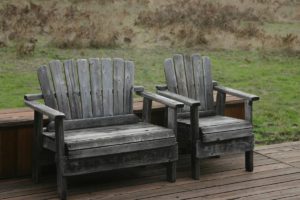You’ve just finished building your brand-new decking, and it’s time to let that baby shine! Not only do you want to accentuate the wood’s natural beauty, but you want to safeguard and protect your timber from deterioration. The final stage of any woodworking project is, of course, selecting the correct finish. With endless options available, it’s wise to determine how much maintenance you wish to pour into your project. Optimal protection is key for timber that will see a lot of traffic — especially decking.
Let’s dive into the oil and polish options available to you:
Timber Oils and Sealers
Timber oil is popular due to its ability to preserve yet highlight the surface’s unique characteristics. It will reduce the risk of cracking, splitting, warping, and colour fading. It can prevent water damage, lock out moisture, and safeguard against insects, mould, rot, and mildew. It’s also relatively easy to apply and maintain — a perk if you’re leading a busy life! While you may think you can slap on any ol’ oil, there are several key differences you should consider before grabbing your roller and broom.

One of the main differences is between water-based and non-water-based oils. Water-based oils (also known as varnishes) are considered to be gentler on the wood and their natural colouring. Non-water-based oils, on the other hand, penetrate into the wood’s fibre and protect it from damage. While this may offer greater protection, these oils will generally darken the appearance of the wood.
If your decking is made from Merbau, an oil — especially water-based — will accentuate the wood’s grain. A non-water-based oil or a Merbau stain will alter the colour of your decking. It all comes down to the overall look you’re after and the amount of protection desired. Opting for a wood stain may be the way to go if you prefer a completely different hue.
Here are the top recommended timber oils:
Linseed
Linseed oil is more regularly used for indoor timber and won’t impact the colouring of your wood. It can also be used to restore the look of wooden antiques. Standard linseed oil can take quite a while to dry and requires multiple coats — sometimes as many as twenty. That’s definitely something to keep in mind when going for it.
Danish
Danish oil is known for its hard-wearing finish — perfect for high-traffic timber, especially a decking exposed to the elements. It provides optimal resistance to water damage and offers a satin finish rather than a glossy, very shiny look. Unlike oil that affects the surface of your decking, Danish oil penetrates deeply into the surface, resulting in a gorgeous wood grain depth.
Teak
Teak oil offers the same penetrative benefits and is both water and UV-resistance. As a combination of oils and solvents, it’s wise to keep in mind that Teak oil isn’t 100% natural, but it will offer a long-lasting finish, as opposed to Danish which requires reapplication. When working with softer woods, such as pine or cedar, Teak or Danish may not be the way to go due to their deep seepage.
Tung
Tung oil is often considered a superior deck sealer than others — giving your timber a fine natural, non-toxic finish. The Chinese have utilised this 100% natural oil for hundreds of years to caulk and paint their boats. Known for its transparency, waterproofing, and flexibility, Tung Oil may be the best choice for your woodworking project. It won’t alter the colour of your wood but provides a soft, glowing appearance.
Varnishes
Varnishes are highly protective against heat, alcohol, water, and other elemental damage. Suitable for both indoor and outdoor projects, varnish doesn’t hide the grain of the wood but presents itself in a transparent form.
Advantages
Heat resistance
Water resistance
UV-proof
Elasticity and humidity tolerance
Disadvantages
Hard to reverse application
Difficult to refinish
Stains
A wood stain is the way to go if you want to enhance or alter the wood’s natural hue. Available in gloss and matte, you can really tailor the end result to suit your desired visual aesthetics. The one downside to using a timber stain is that it doesn’t offer protection against water and requires frequent recoating. It’s vital to bear in mind that stains are more about aesthetics than protection.
Advantages
Colour longevity
Danish and Teak oils are ideal for harder woods — sinking deeper into the wood’s fibre and accentuating the grain. If you’re working with softer woods or prefer oil that’s 100% natural, you can’t go wrong with Tung oil. Used by cultures for thousands of years, this oil provides optimal protection and natural visual appeal.
When talking specifically about timber flooring, as opposed to the oiling deck, there are other methods down the track to restore your wood, including timber floor polishes. Depending on the amount of traffic on your floors, these can be applied every few months or years to remove dents and scratches.
Moisture resistance
Grain and texture unaffected
Rot prevention
Heat protection
Disadvantages
Short lifespan
Only suitable for certain wood types
Timber Floor Polish
Timber floor polish can restore, enhance, and protect your flooring. Some polishes can fill in scratches, restore your glossy shine, rejuvenate dull spots, and eliminate dirt, greasiness, and grime on hardwood floors. Floor polish is generally used after the application of your initial oils and varnishes to restore and maintain your timber’s glossy finish.
Wax Polish
Wax polish is recommended for smaller woodworking projects — such as a table rather than a decking — and can provide depth of colour and protection. It’s often used as a finishing touch to wood dyes. Wax is easy to apply, can give your timber a stunning translucent decorative finish, and can be used over other finishes.
So, which is the best for your timber project?
There are several things to consider, including the degree of protection, longevity of protection, required maintenance, application, and visual appeal. While some stains may provide a gorgeous colour finish and resistance against the elements, oils offer longer-lasting results and minimal upkeep. You also have to keep in mind the softness of your timber and how oil, varnish, or stain may affect its fibre and visual aesthetic.
You can bring out the character and charm of your timber in different ways.
